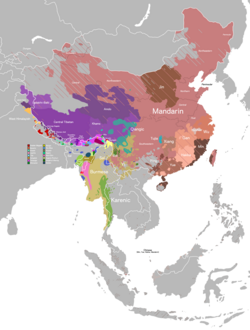Derung language
Dulong (simplified Chinese: 独龙语; traditional Chinese: 獨龍語; pinyin: Dúlóng) or Drung, Derung, Rawang, or Trung, is a Sino-Tibetan language in China. Dulong is closely related to the Rawang language of Myanmar (Burma).[2] Although almost all ethnic Derung people speak the language to some degree, most are multilingual, also speaking Burmese, Lisu, and Mandarin Chinese[1] except for a few very elderly people.[3] Dulong is also called: Taron, Kiu, Qui, Kiutze, Qiuzi, Kiupa, Kiao, Metu, Melam, Tamalu, Tukiumu, Qiu, Nung, Nu-tzŭ.[4] ClassificationDulong belongs to the Nungish language family of the Central Tibeto-Burman branch of the Tibeto-Burman branch of the Sino-Tibetan language family.[1] The other two languages in the same family are Anong and Rawang. HistoryDulong/Rawang is a Tibeto-Burman language cluster spoken on both sides of the China/Myanmar border just south and east of Tibet. Within Myanmar, the people who speak the Dulong language (possibly up to 100,000 people) live in northern Kachin State, particularly along the Mae Hka ('Nmai Hka) and Mali Hka (Mali Hka) River valleys. In the past, they had been called 'Hkanung' or 'Nung', and have often been considered to be a subgroup of the Kachin (Jinghpaw). Around 1950, speakers of this language in Myanmar began a movement to use the name /rəwɑŋ/ (spelled 'Rvwang' in the Rawang orthographies) to represent all of its speakers. The speakers in China, though, continue to use the name 'Dulong'.[5] Geographic distributionThere are 14,000 (2,000 census) people speaking in two dialects: 8,500 in Nu River dialect, and 5,500 in Dulong River dialect. The locations of Dulong are Yunnan province (Gongshan Dulong-Nu autonomous county), Xizang Autonomous Region (Chayu (Zayü) county, Chawalong Town), and Bingzhongluo.[1] In the past, the Dulong River was known as the Kiu (Qiu) river, and the Dulong people were known as the Kiu (Qiu), Kiutze (Qiuzi), Kiupa, or Kiao.[2] DialectsDulong has two dialects: Dulong River (Central Dulongjiang, Derung River, Northern Dulongjiang, Southern Dulongjiang), and Nu River (Nujiang Dulong). Dialects reportedly inherently intelligible (Thurgood and LaPolla 2003). Other possible dialect names are Melam, Metu, Tamalu, and Tukiumu.[1] PhonologyConsonants
Dulong has twenty-four initial consonants at six points of articulation, plus the consonant clusters /pr, br, mr, kr, xr, ɡr, pl, bl, ml, kl, ɡl/ in initial position; only the consonants /p, t, ʔ, k, n, m, ŋ, r, l/ occur in final position.[2] VowelsDulong has seven vowels, /i, ε, ə, ɑ, ɔ, ɯ, u/, and three diphthongs, /əi, ɑi, ɯi/, which only appear in open syllables. Vowel length is also evenly distributed.[2][6] TonesDulong has 3 tones: high level, high falling, and low falling. In the Dulong language, tone has the role of differentiating the meaning of a few words, with about 8% words (out of about 4000) completely relying on tones to distinguish them.[7] Writing systemA Derung alphabet based on the Latin script was developed in 1983, but it is not widely used and is not officially recognized.[8] Initials:
Finals:
/ʌ/ is written a at the beginning of word. Tones are unmarked. The letter X is not used, and the C is only used in the digraph Ch. The letter V is used as a vowel, not as a consonant. GrammarWords can be formed by prefixation, suffixation, or compounding. Word classes include nouns, defined by the ability to appear with a numeral classifier; verbs, defined by the ability to appear with negation and the person and tense marking; postpositions, which are enclitic to NPs, numerals, and classifiers. Adjectives are a subset of stative verbs for which reduplication means intensification or adverbialization rather than the perfective aspect (reduplication with nouns has a distributive meaning, ‘every’). Adjectives can be used as predicates or can appear nominalized in a copula clause.[2] The grammar of the language is documented extensively by Perlin (2019).[9] Verb conjugationDerung verbs inflect fusionally for person and number and agglutinatively otherwise. Verbal conjugation uses a mix of affixes, a direct-inverse person-marking hierarchy, apophony, and tone changes.[9] Intransitive verbsIntransitive verbs are conjugated to agree with the subject in person and number. The first-person plural form is formed via vowel ablaut, primarily characterized by the lengthening of the root vowel. If the root vowel is the schwa /ə/, the schwa is replaced with /ɑː/. If the root ends in /ɑ, u, ɯ/, these vowels are further converted into long diphthongs /ɑːi, uːi, ɯːi/.
Transitive verbsTransitive verbs in Derung may exhibit agreement with both their agent and their patient, and conjugate for three grammatical persons (1st, 2nd, and 3rd) and three grammatical numbers (singular, dual, and plural). However, the appearance of agreement is also governed by pragmatic factors. The prefix /nə³¹/ (which Perlin calls a "marked scenario prefix") appears if one of the two following conditions is satisfied:
On top of the "marked scenario prefix", Derung transitive conjugation shows extensive stem allomorphy. The principal stems can be listed as follows:
The general conjugation of a transitive Derung verb is as follows:
NegationDerung verbs are negated by prefixing mə³¹ (which also surfaces as an allomorph mɑ³¹). The negative prefix also contracts with the copula ɛ⁵³ to form mɛ⁵⁵, and also with əl⁵³ "to have" to form mɑl⁵³. Tense, aspect, mood and evidentiality markersDerung has an elaborate set of markers that normally follow a verb that mark tense–aspect–mood distinctions, as well as evidentiality and mirativity. Mirativity and evidentialityDerung has two separate markers that Perlin assigns "mirative" meaning, namely /ɹɑ³¹/ to mark directly witnessed events and /mɯ³¹/ to mark events that are deduced to have happened. /tɕi³¹/ marks something that is customary or common knowledge, while /wɑ³¹/ marks something that the speaker heard from someone else. VocabularyDerung shares 74% lexical similarity with the Matwang dialect of Rawang, and 73% to 76% with Anong.[1] References
External links
|
|||||||||||||||||||||||||||||||||||||||||||||||||||||||||||||||||||||||||||||||||||||||||||||||||||||||||||||||||||||||||||||||||||||||||||||||||||||||||||||||||||||||||||||||||||||||||||||||||














